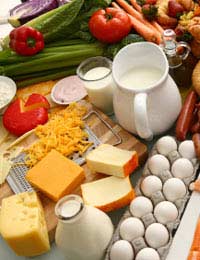Understanding the Different Food Groups

Understanding the five different food groups will help you to enjoy a healthy, balanced diet.
Each of the different food groups fulfils a function for your body’s wellbeing, so there is no reason to cut one or more of them out. Unless you have personal or religious reasons for not wanting to eat a certain food group, plan to enjoy the suggested portion sizes for each food group and you will know that you are eating a balanced diet.
Fruit And Vegetables
All fresh, frozen and tinned fruits and vegetables are good to eat, although do be careful that tinned products, in particular, are not in sugary syrup. Frozen vegetables can also often come with butter and sauces, as can ‘ready to microwave’ vegetables that are in the ready meal fridges in supermarkets.The best way to eat fruit and vegetables is without extra sauces, although any way that you can include more fruit and vegetables in your diet is good. Lightly steamed vegetables are delicious, and a fresh fruit salad takes some beating.
It is recommended that you eat at least five portions of fruit and vegetables a day, which can include up to one glass of juice, smoothies, an apple/orange/banana, a handful of grapes, five dried apricots or a large slice of melon.
Milk And Dairy
Milk and dairy provide vitamins B12, A and D and are great for building healthy teeth and bones. It is especially important that children are not given the low fat versions, unless advised by a doctor.It is advised that you eat around three portions a day, which can include a 200 ml glass of milk, a match box sized piece of cheese or three cheese triangles.
Carbohydrates
Carbohydrates help to keep you full of energy and not feeling hungry. Carbohydrates are the ‘starch’ element of your meal, such as potatoes, pasta and rice.It is advisable to try to choose the wholegrain version of your carbohydrates as often as possible as they keep you feeling fuller for longer and are unprocessed.
It is advised that you eat some carbohydrates with every meal and snack, although do be careful not to have too big a portion as it can make you feel sluggish. Aim for a tea-cup sized portion of cooked pasta, rice or potatoes.
Fats And Sugars
Fats and sugars are to be enjoyed less often – certainly not every day – as they contain a lot of calories and very little nutritional value.Processed white sugar is not good for your metabolism, so you may prefer to get your sweetness from natural sugars such as honey. Some fats are good for you, so choose wisely – an avocado contains fats that help support your skin, whereas chocolate may make you feel good, but you won’t look so good!
Meat And Proteins
Meat is a great source of protein, but you can also make sure that your diet is high in protein if you do not choose to eat meat.You need to include protein with each meal and snack as it helps you to feel full without too many calories. Protein is very important for the health and development of your body and, if you are watching your weight, great for feeling full without looking bloated.
Sources of non-meat protein include lentils, legumes, tofu and soya products.
- Drying Seasonal Ingredients
- Preserving and Bottling Your Produce
- Making the Most of Your Oven
- 5 a Day? Getting More Fruit and Veg in Your Diet
- Sticking to a Budget
- Feeding Fussy Children
- Temperature and Timings
- The Rules of Food Storage
- What is a Balanced Meal?
- Good Food Preparation
- Effective Meal Planning when You Live Alone
- Using Leftovers for a Cheap, Delicious Meal
- Effective Meal Planning for a Family


Re: Caring for Your Cooking Equipment
Is it possible to purchase protective blade covers for a Cooks Essential mini food chopper.
Re: Little Touches to Impress Without the Stress
Hi, Years ago my mom bought one of your hand held mixers. Sadly when she passed I obtained it and love it.…
Re: Caring for Your Cooking Equipment
23cm pan. Double handle and lid. Lid handle has broken. Non stick lining has eroded off.
Re: Still in the Box? Equipment That Never Gets Used
Air Fryer model No: 805223. 1400w (White). Has been put away without cleaning properly for quite a long…
Re: Still in the Box? Equipment That Never Gets Used
Do you have a manual for the Air fryer model 805933. Thank you
Re: Five Things You Didn't Know You Could Make in a Slow Cooker
Is it possible to replace a translucent condensation collector? I have mislaid mine. I…
Re: Essential Baking and Cooking Equipment
Hi, I wonder if you can give me some advice. I have been a fan of Cooks Essential cooking pans for many years and…
Re: Cooking for a Crowd - Basic Ideas with Great Results
I would love some recipes for pressure cooker or a recipe book
Re: Caring for Your Cooking Equipment
Can I purchase a handle for a frying pan, it is spring loaded, my wife dropped it and has broken.
Re: Slow Cooker Puddings
Holsgirl - Your Question:What size pudding basin should be used for Sticky Toffee Pudding and Chocolate Pots?Thanks